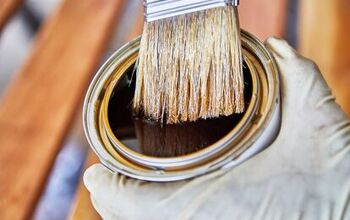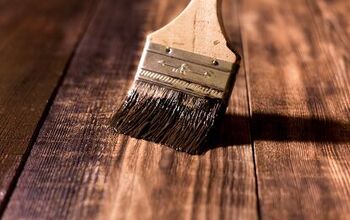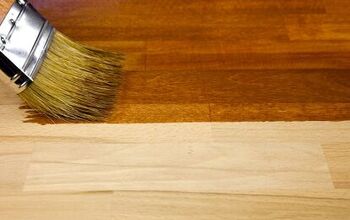Can You Use Wood Stain On Metal Surfaces?

Wood stains are incredible for your home improvement project, no joke there! Every deck, cabinet, and wooden tchotchke needs a coat of stain to keep it safe from the elements. Wood stains are great for wood, but can they be used for other materials? Well, quite possibly. Many rumors on the net suggest using it on metal, but whether this is true or not remains up for debate. Kinda.
Traditional wood stains are made to sink into wood. They offer a low viscosity that is ideal for wood painting and permanent use. Unfortunately, the penetrating formulation and low viscosity of wood stain means that they are highly ineffective for usage on metal. Gel stains, on the other hand, can work on both wood and metal.
Using a wood stain can be a great choice for a wide range of different projects, but if you were hoping to use leftover stain on metal, you’ll be disappointed. Let’s talk a bit about why this is the case.
Do You Need Painting or Staining Services?
Get free, zero-commitment quotes from pro contractors near you.

Before You Begin: Is It Possible To Stain Metal?
Here’s something that people tend to forget about metal: it can be stained. Sure, this a process that’s typically associated with woodworking, but with the right material, you can also stain metal too. However, you need to have the right type of stain if you want to gently alter the color of your metal.
Is Traditional Wood Stain Good For Use On Metal?
Wood and metal are totally different when it comes to the type of materials that can be used on them, especially in terms of stains. Wood is porous and is best served by stains that are meant to permeate easily. This is why wood stains tend to dye through the first couple of millimeters of wood. Traditional wood stains are light and highly viscous, which means that it will be better for sinking in through the pores of the wood.
Metal, on the other hand, needs to have paints and tints that sit on the surface. This is because metal isn’t porous. So, rather than sinking into the material, the stain in question needs to be able to cling on top of the surface instead. Sometimes, actually making a chemical reaction is better.
Is Staining Metal Easy?
Yes and no. You won’t have to sand things down like you would have to if you wanted to stain a wooden item. However, if you already have stain on there, you will have to get stain stripper that’s made for metal. Moreover, you still have to prep the area and treat it appropriately if you want to make it look good.
What Kind Of Stains Are Best For Metal?
There are two primary types of stains that one can use for staining metal: glass stains and gel stains. Let’s discuss why they work and how they can be the right choice for your project.
What Are Glass Stains, And How Do They Work With Metal?
Most people who choose to stain a metal surface do so with glass stains. This is a type of stain lacquer (erm, material) that is meant to be thick and capable of clinging to a perfectly smooth surface. Since glass stains are durable and capable of retaining color very well, they tend to be a good choice for people who want to add a stylistic touch to a statement piece.
Glass stains are what make windows get that unique color splash that people associate with “stained glass,” obviously. When applied to metal, it’s usually not quite as vibrant. Rather, it tends to offer a subtle kiss of color unless multiple layers are applied. These stains tend to dry smooth, which means that your metal will look painted while still being metallic.
What Are Gel Stains, And How Do They Work With Metal?
It’s easy to see why people prefer glass stains. They are made for materials that are more similar to metal than wood. However, there is another option that you can choose for staining metal: gel stains. Let’s talk a little bit more about these and why people tend to want to use them when they are trying to add a bit of color to metal…
Gel stains are a unique genre of wood stains that are a bit different from traditional stains. As the name suggests, gel stains are thicker than a traditional stain. These are stains that are thicker, clingier, and more pigmented than a typical wood stain would be. As a result, they can “sit” on the surface of wood as well as penetrate them.
Because gel stains are thicker than regular stains, they are made to sit, cling to, and dry on surfaces. This makes them good for surfaces that aren’t always porous, or for surfaces that are vertical. This is also why many people choose to use gel stain on garage doors, even when the doors are made of metal. Gel stains tend to give metal a wooden look, which is why they’re great with garage doors.
What Are Patina Stains And How Do They Work With Metal?
Patina stains are specially made for metal, and they are made to give your metal a specific look that matches the patina that is often seen in copper. In other words, it’s a way to paint on an aged metal look, even when the metal in question is fairly new…or not even copper at all. Like gel stains, these stains tend to sit on top of metal rather than try to soak in.
These stains are rather rare when it comes to being used, they definitely add a nice flair to things. These are your best bet if you want to make metals appear aged or otherwise give metals a slightly trippy appearance. Most of the time, the patina added is bronze, green, or copper-red in appearance. However, there are stains out there that are black, or even purple. They can also be mixed for added dimension.
Unlike all other stains, these are made specifically for use on metal. This makes them the most obvious choice for people who want to opt for easy-to-use staining.
Do You Need Painting or Staining Services?
Get free, zero-commitment quotes from pro contractors near you.

Related Questions
Which is better for metal, paint or stain?
Assuming that you choose a stain type that is actually capable of sticking to metal, using a stain is doable. However, it’s not easy to compare paints to stains on metal. Stains tend to have a slightly subtle kiss of color that keeps metal looking more like metal than any other substance. With paint, your metal can take on the appearance of lacquer, plastic, or even wood. So, it’s about the effect that you want to get.
How can you make a metal door look more like wood?
The easiest way to make a metal door look more wooden is to employ painting techniques that mimic the texture and appearance of wood. Adding knotholes, creating a faux wood grain using a paintbrush, and also choosing paints that are famous for giving a subtle texture to your work can all help. With paint, it’s easy to get the illusion of a specific texture.Paint is affordable, easy to handle, and can fake up almost any appearance with enough skill. This is why it is such a popular way to change up the look of items in your home.
Is there a type of spray paint that looks like wood?
If you want to spraypaint a metal item to look like wood, you can. There are several common paint colors that offer a wood-like look if you want to give your items an uplift. Go for “wood look” spraypaint or richer browns. Most brands will have one or two selections that are known for giving a look that is similar to the appearance of mahogany or cherry. It’s a good way to add that flair you want.
Related Articles

Ossiana Tepfenhart is an expert writer, focusing on interior design and general home tips. Writing is her life, and it's what she does best. Her interests include art and real estate investments.
More by Ossiana Tepfenhart



















![Cost To Drill A Well [Pricing Per Foot & Cost By State]](https://cdn-fastly.upgradedhome.com/media/2023/07/31/9074980/cost-to-drill-a-well-pricing-per-foot-cost-by-state.jpg?size=350x220)

![10 Most Dangerous Neighborhoods in Baltimore [Updated]](https://cdn-fastly.upgradedhome.com/media/2023/07/31/9075655/10-most-dangerous-neighborhoods-in-baltimore-updated.jpg?size=350x220)





